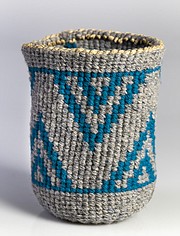Weaving history into the present
Coeur d'Alene Tribal member and established artist Leanne Campbell is looking forward to having a hands-on experience with history.
Campbell, of Tensed, received the exciting news earlier this month that she is a recipient of a Burke Museum Bill Holm Center for the Study of Northwest Native Art Visiting Researcher Grant. She will spend three days at the Burke Museum of Natural History and Culture in Seattle next week, when she will examine historical Columbia Plateau basket hats and Columbia Plateau sally bags (round root bags) in the museum’s Contemporary Culture Collections. She’ll also present a one-day weaving demonstration for the museum and its patrons while there.
The museum grant is covering her expenses for airfare and five days of lodging, estimated to be between $1,500 and $2,000.
Campbell is one of just 31 grant recipients for the Bill Holm Center’s annual Connections to Culture Program grants. These grants include individual artists, group visits for a team of artists and their mentors and/or apprentices, as well as workshop grants that take place both at the Burke and in communities throughout the Northwest.
The mission of the Connections to Culture program is to support Native artists in their learning and practice by providing access to historical collections and to aid in the transmission of artistic knowledge throughout communities across generations.
"I've been producing traditional arts for over 20 years," Campbell said Monday. "The work that I do really focuses on the history and the culture, the language and traditional arts of the Coeur d'Alene Tribe and the Columbia Plateau Region."
Campbell will have opportunities to study historical items that have survived the test of time to tell the stories of the Coeur d'Alene, Yakima, Nez Perce, Wasco and the more than 50 tribes of the Columbia Plateau region, which stretches across more than 100,000 square miles of Idaho, Washington and Oregon.
“These are wonderful older examples of our baskets," she said. "I want to study basic elements such as: construction of the start of the baskets, materials used, colors and design elements, woven add-ins to create the flair of the basket hat, and overall counts of finished hats. I am inspired by older works and pay great attention to details and design work. I am always interested in our Columbia Plateau cultural heritage design work as these designs tell stories and each of the design elements have meaning."
The heritage designs of these ancient baskets include tales of the people, landscapes, animals and more.
"They all have meaning," Campbell said. "These are really valuable connections to our past. Not that we’re a culture that is dying or is gone — we're a living and breathing continuing culture."
Campbell learned the art of twined basketry nearly 20 years ago. She uses hemp twine, wool and acrylic yarns and raffia to create Columbia Plateau basket hats and sally bags.
"My basketry features Columbia Plateau cultural heritage design work expressed in modern materials that speak volumes to the resiliency of our culture and traditional arts," she said.
She said these pieces and techniques are “connected with our worldview, our ceremonies, our dance, our songs, our prayers.
“We still use these in our traditional food-gathering practices,” she said. “It’s pretty interesting too that we can produce work that is sought after by collectors in museums, but I can also make a basket and get it dirty to just go dig roots and pick huckleberries.”
Campbell, who is the culture tourism coordinator at Coeur d’Alene Casino Resort, was awarded a $4,900 workshop grant from the Burke Museum, as well. She will conduct this workshop on Columbia Plateau basket hats in North Idaho in November.
"What I'm hoping is to bring back some of that traditional knowledge and to host a workshop that can focus on intergenerational learning that I can infuse with culture and language, and some of our heritage stories that explain the heritage design work that I'm trying to bring back," she said. "What I’d like to see in my workshop later this year is that we can get a really wide range of ages, from late 20s to 80s, with really diverse culture and language experience."
Campell was also a 2019 recipient of the Idaho State Historical Society's Esto Perpetua Award, a high honor that recognizes individuals and organizations who have made significant contributions to the preservation of Idaho history.





